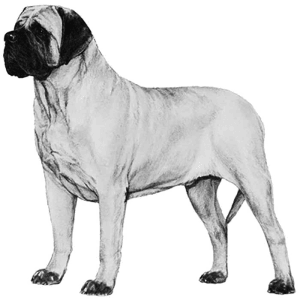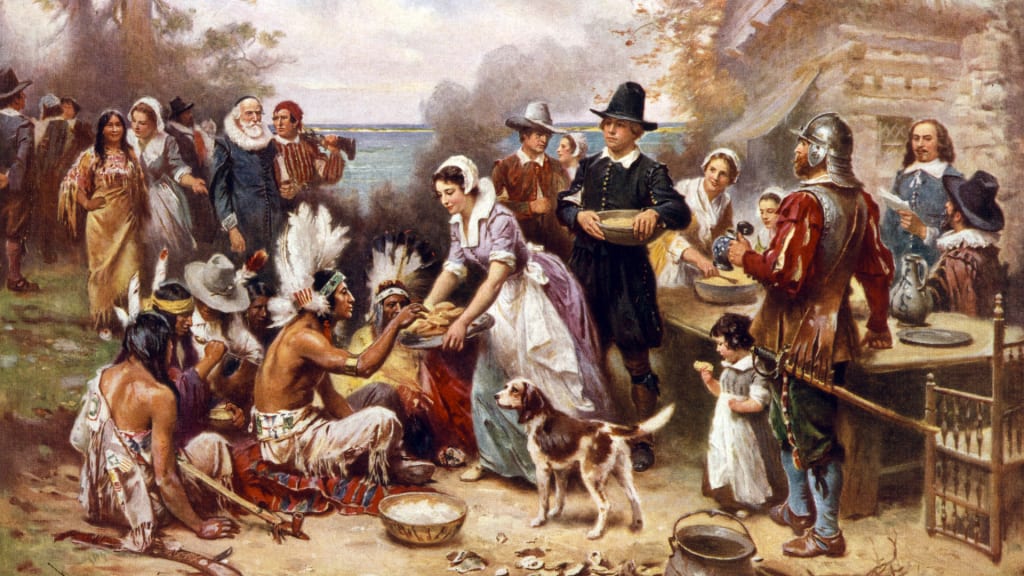The Pilgrims weren’t the only ones who arrived at Plymouth in 1620. They brought dogs on the Mayflower with them. These Pilgrim pups might have been present at the first Thanksgiving.
How do we know there were dogs on the Mayflower?
Thanks to journals the Pilgrims kept, we know that there were at least two dogs on the Mayflower: a Mastiff and a Spaniel. They traveled with a Pilgrim named John Goodman. Stories about these two dogs show up in the Pilgrims’ historical records, although we don’t know their names.
A Mastiff and a Spaniel
There are some good reasons why the Pilgrims brought a Mastiff and a Spaniel on the Mayflower with them.
Mastiffs descend from the Mollosus, a strong, heavy-boned war dog. This ancestry can also be seen in other large modern dogs, such as the Saint Bernard and the Dogue de Bordeaux. The modern Mastiff was bred in England in the 15th century. Their huge size makes them very capable guard dogs. Mastiffs are known for their protective instincts, so we can guess that this Mastiff was likely there for protection in the New World.

We don’t know the names of these two dogs on the Mayflower, but we can use our imaginations. In fact, a children’s book called The Mighty Mastiff of the Mayflower imagines what life would have been like for this Mastiff who sailed with the Pilgrims. It’s written by Peter Arenstam, who grew up in Plymouth and now oversees the Mayflower II (a reproduction of the original Mayflower).
Spaniels were bred as hunting dogs due to their strong flushing ability. It’s likely that Goodman brought his Spaniel to help the Pilgrims hunt and find food.
Some accounts say that the Spaniel on the Mayflower was an English Springer Spaniel, although the American Kennel Club points out that isn’t really true. This breed had not been established back then. In the 1600s, all Spaniels were considered pretty much the same.

How many dogs were on the Mayflower?
Although we only know for sure about two dogs on the Mayflower, there may have been more. Embark’s own Lisa Peterson tells us that, back then, it was customary to present a ship’s captain with a puppy at every port. Master Jones, the captain of the Mayflower, might have brought hunting hounds with him.
Another reason we think the Pilgrims probably brought more than two dogs on the Mayflower is because they survived at Plymouth, suggesting they might have had hunting dogs to help them find food.
The dogs on the Mayflower helped out at Plymouth Colony
The two dogs on the Mayflower helped the Pilgrims survive their first harsh winter.
One day, John Goodman and another Pilgrim took the Mayflower dogs with them as they went out into the wilderness. They couldn’t find their way home and had to spend a cold night in the woods. The next day, the dogs helped them navigate back to the Pilgrims. Without the Mastiff and the Spaniel, Goodman and his friend might not have survived.
Sadly, Goodman died before the first Thanksgiving, but the other Pilgrims looked after his dogs after his death.
Indigenous dogs in the Americas
The Pilgrim dogs weren’t the only dogs living in the Americas at the time. Native Americans had dogs, too, long before Europeans arrived. These early American dogs were related to Arctic breeds like Huskies and Malamutes. They probably migrated with early humans across the Bering land bridge. Although we don’t know for sure, it’s possible that some of the Native American dogs were present at the first Thanksgiving.

Of note in this painting of the first Thanksgiving by John Leon Gerome Ferris is the Spaniel in the foreground, although we don’t know whether Goodman’s Spaniel was actually at the feast. This painting was done in the early 1900s and shows an idealized version of the Thanksgiving feast. Many elements of this painting are disputed by historians today, including the story of the first Thanksgiving, and are likely not historically accurate.
Dogs were in America 10,000 years ago
Dogs were in the Americas long before the Pilgrims arrived in 1620. Archaeologists found ancient dog remains in Illinois, dating back about 10,000 years ago. These dogs, known as the Koster dogs, are the oldest known individually buried canines. That means that ancient humans gave these dogs a separate burial, likely to honor them as beloved pets or prized hunting dogs. This discovery shows that “dogs had a very special place in indigenous communities,” just like they do today.
Native American dog DNA is scarce
For the most part, modern dog DNA comes from European dogs that explorers brought with them to the Americas, like the two dogs on the Mayflower. There’s very little DNA from Native American dogs still present in dogs today.
But scientists have found that some dog breeds have ancient American heritage. These breeds, like the Chinese Crested Dog and the Xolo, have some genes that come from the indigenous dogs that were living in the Americas before the Europeans arrived.
There is also some evidence of ancient Native American dog DNA in a type of canine tumor that still exists today. The original dog who had this tumor was likely a North American dog who lived up to 8,225 years ago. Here’s what we know about that dog from its DNA: it wasn’t small, it didn’t have short hair, and it was “a bit wolfy.”
What we know from history and DNA suggests that wherever people go, dogs go, too.













